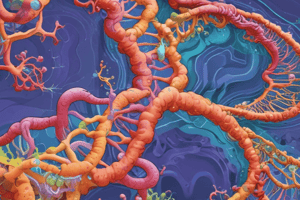Podcast
Questions and Answers
What is the flow of Ty-1 sequence information during transposition?
What is the flow of Ty-1 sequence information during transposition?
- DNA to DNA to RNA
- RNA to DNA to RNA
- RNA to DNA to Protein
- DNA to RNA to DNA (correct)
What can transposable elements cause in the genome?
What can transposable elements cause in the genome?
- Increasing the size of genes
- Deleting all genes
- Additional rearrangements (correct)
- Enhancing gene regulation
What is the outcome of recombination between two transposable elements in the same orientation?
What is the outcome of recombination between two transposable elements in the same orientation?
- Inversion
- Deletion (correct)
- Duplication
- Translation
What is the predicted mechanism if yeast Ty-1 moved as illustrated for DNA-mediated replicative transposition?
What is the predicted mechanism if yeast Ty-1 moved as illustrated for DNA-mediated replicative transposition?
What happens if recombination occurs between two transposable elements in opposite orientations?
What happens if recombination occurs between two transposable elements in opposite orientations?
Does the retrotransposition machinery have an absolute preference for LINE1 mRNA?
Does the retrotransposition machinery have an absolute preference for LINE1 mRNA?
What is the primary defining feature of transposons?
What is the primary defining feature of transposons?
Which type of cells contain transposons?
Which type of cells contain transposons?
What is one role of transposases in the transposition process?
What is one role of transposases in the transposition process?
How do transposons cause genetic mutations?
How do transposons cause genetic mutations?
Which statement accurately describes transposons in the human genome?
Which statement accurately describes transposons in the human genome?
What distinguishes the two major classes of transposable elements?
What distinguishes the two major classes of transposable elements?
What is the main difference between replicative and nonreplicative transposition?
What is the main difference between replicative and nonreplicative transposition?
How does replicative transposition differ from nonreplicative transposition in terms of DNA synthesis?
How does replicative transposition differ from nonreplicative transposition in terms of DNA synthesis?
What is the significance of the strand-transfer intermediate in transposition?
What is the significance of the strand-transfer intermediate in transposition?
How does nonreplicative transposition differ from replicative transposition in terms of cointegrate intermediate formation?
How does nonreplicative transposition differ from replicative transposition in terms of cointegrate intermediate formation?
What happens to the transposon in an alternative pathway for nonreplicative transposition?
What happens to the transposon in an alternative pathway for nonreplicative transposition?
What is common between replicative and nonreplicative transposition regarding generating the strand-transfer intermediate?
What is common between replicative and nonreplicative transposition regarding generating the strand-transfer intermediate?




